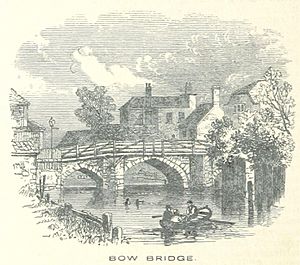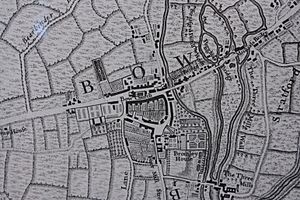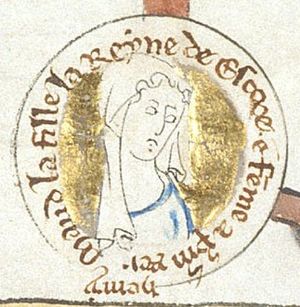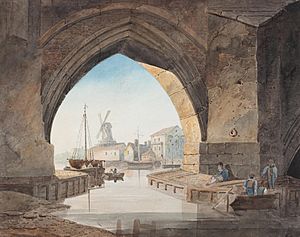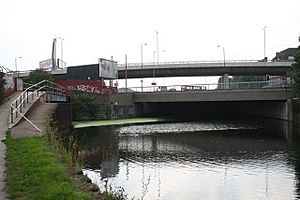Bow Bridge, London facts for kids
Bow Bridge was a stone bridge built a long time ago, in the 1100s, over the River Lea in what is now London. It got its name because its arches were shaped like a bow (curved).
This important bridge connected the areas of Bow (in Middlesex) and Stratford (in Essex). Even today, the name "Bow Bridge" is used for the newer bridges that replaced it. The current bridge is also known as the Bow Flyover.
Before this bridge was built, a Roman road used to cross the River Lea further north at a place called Old Ford. The new Bow Bridge made the main road take a different, more southerly path. This road is known by different names along its way, like Bow Road and High Street, but it was once called the Great Essex Road.
Before the first bridge, both sides of the river were called Stratford. After the bridge, the western side became known as “Stratford-atte-Bow” (meaning "Stratford at the Bow"), which eventually shortened to just Bow. The eastern side became "Stratford Langthorne" because of a big tree, but it later lost that part and is now simply Stratford.
A battle even took place at Bow Bridge on June 4, 1648, during the Wars of the Three Kingdoms.
Contents
Why Bow Bridge Was Built
In 1110, Queen Matilda, who was married to King Henry I, tried to cross the River Lea. She was on her way to Barking Abbey. The Queen, or some people with her, accidentally fell into the water. This was quite dangerous, especially with the heavy clothes people wore back then!
Building the Bridges
Because of this accident, Queen Matilda ordered a special bow-shaped (arched) bridge to be built over the River Lea. A small chapel dedicated to St Katherine was also built on the bridge.
This bridge was built in a farming area, about 3 miles (4.8 km) east of London's city wall. Along with Bow Bridge, four smaller bridges were built over the nearby Bow Back Rivers. A new raised road, called a causeway, connected all these bridges. This road is now Stratford High Street.
The five bridges, from west to east, were:
- Bow Bridge: The biggest one, crossing the main part of the River Lea.
- St Michael's Bridge (also called Harrow Bridge): Over the western part of the Waterworks River.
- Pegshole Bridge: Over the eastern part of the Waterworks River.
- St Thomas of Acre's Bridge (or St Thomas's Bridge): Over the Three Mills Back River.
- Channelsea Bridge: The second largest, crossing the Channelsea River.
Keeping the Bridges Maintained
At first, land and a mill were given to Barking Abbey to help pay for the bridge's upkeep. But this job eventually passed to Stratford Langthorne Abbey. The leaders of these two abbeys argued about who should pay for the bridge's care. In 1315, they agreed that Stratford Langthorne Abbey would maintain the bridge and road, and Barking Abbey would pay them £200 each year.
Later, when the abbeys were closed down, there were more arguments about who was responsible for the bridge. This was finally sorted out in 1834 when a special group called a Turnpike Trust was formed to manage the road and bridge.
Bow Bridge in Songs
Some versions of the famous nursery rhyme London Bridge Is Falling Down actually mention Bow Bridge! One of the oldest known versions, from the 1820s, had these words:
London Bridge is broken down,
Dance over the Lady Lea;
London Bridge is broken down,
With a gay lay-dee.
People have different ideas about who the Fair Lady in the song might be. Some think it could be Queen Matilda, who built Bow Bridge and the other bridges. Others believe it might refer to the River Lea itself.
Bow Bridge in Books
In 1724, Daniel Defoe started writing a book about his travels around Britain called A Tour thro' the Whole Island of Great Britain. He began his journey in Essex, crossing the Lea at Bow Bridge.
Passing Bow-Bridge, where the county of Essex begins, the first observation I made was, that all the villages which may be called the neighbourhood of the city of London on this, as well as on the other sides thereof, which I shall speak to in their order; I say, all those villages are increased in buildings to a strange degree, within the compass of about 20 or 30 years past at the most.
—Daniel Defoe, A Tour thro' the Whole Island of Great Britain 1724
Its Important Location
Bow Bridge was the lowest crossing point on the River Lea. The river used to be much wilder and harder to cross. This made the bridge a very important spot for trade and for armies moving between east and west. For example, during the Peasants' Revolt in 1381, forces from Essex crossed the bridge. Also, in 1471, during the Wars of the Roses, soldiers supporting the Lancastrian side crossed it. They then tried to attack London's city walls.
Battle of Bow Bridge
- Further information: [[Wars of the Three Kingdoms, First English Civil War, Second English Civil War]]
What Led to the Battle
The Battle of Naseby in 1645 mostly ended the hopes of King Charles I winning the First English Civil War. However, the war continued. In 1648, there were new uprisings by people who supported the King, especially in Kent and Essex. London and the eastern areas had mostly supported Parliament, but some people were getting tired of the war.
Before the Fight
A Parliamentarian army quickly captured Maidstone on June 1. Despite this, a large group of Royalists (King's supporters) from Kent, led by the Earl of Norwich, marched towards London. They hoped the city would rise up and join them. Many Royalists gave up along the way, so by June 3, only about 3,000 men reached Greenwich.
There were not many Parliamentarian soldiers left in London. But under the strong leadership of Philip Skippon, they quickly closed the city gates and fortified London Bridge. Most of the Royalists gave up at this point. Only about 500 foot soldiers and some horsemen remained.
The Earl of Norwich heard that more Royalists were gathering at Bow Bridge and Chelmsford. He crossed the river with his horsemen to check if this was true. He wanted his army to join them if the information was correct. Sir William Compton was left in charge of the Royalist force at Greenwich. Norwich found no army at Bow Bridge, so he continued to Chelmsford.
When Norwich didn't return right away, the Kentish Royalists decided to cross the river themselves. They landed on the east side of the Isle of Dogs peninsula, many at Blackwall.
The Fight Itself
The Royalists mistakenly thought they were in Essex, an area they believed would be friendly or lightly defended. Instead, they were in Tower Hamlets in Middlesex, which was hostile. The Tower Hamlets Militia, a respected local defense force, arrived to confront them. The Royalists, who had landed in a messy way, were not ready to fight.
The Militia leader decided to avoid a big fight. He told the Royalists they would be escorted to Bow Bridge, disarmed, and then allowed to leave. But before reaching the bridge, the Royalists got themselves into better order. They managed to scare the few Essex musketeers on the bridge into letting them pass without giving up their weapons. They even took the Militia major and another officer as hostages, releasing them after safely crossing the bridge.
Soon after crossing, they met the Earl of Norwich and his Royalist cavalry. At the same time, Parliamentarian horsemen from Whalley's Regiment of Horse arrived on the Bow side of the bridge.
The Earl of Norwich immediately charged the Parliamentarian cavalry. Some were killed, and the rest retreated. Norwich chased them towards Aldgate on London's city wall. But they ran into an ambush! Parliamentarian dragoons (mounted gunmen) were hiding behind hedges at Mile End Green. They fired at the Royalists, killing one. This was the closest any Royalist force got to London during the civil wars.
The Royalists retreated back to Bow Bridge. Meanwhile, Whalley's Regiment and the dragoons rushed back to London to warn everyone. Near Bow Bridge, the Royalist cavalry, likely helped by their foot soldiers, forced the Tower Hamlets Militia to hide in Bow Church. The Militia then had to surrender to the Royalists.
What Happened After
The Royalists stayed in Stratford for several days. They carefully guarded Bow Bridge and other river crossings to protect themselves from attacks from London. The Earl of Norwich used this time to try and gather more support from local leaders in Essex. Even though their march on London failed, the Royalists' ability to join up with other supporters and move to Colchester was a small victory for them.
The Royalists then marched towards Colchester, where more supporters joined them. A Parliamentarian force caught up with them just as they were entering Colchester's old city walls. A fierce battle took place, but the Royalists managed to get inside the city walls for safety. This led to the Siege of Colchester. After ten weeks, the Royalists ran out of food and heard about other Royalist defeats, so they surrendered.
New Bridges and Changes
The original Bow Bridge was made wider in 1741. People had to pay tolls to help cover the costs. Arguments about who should maintain the bridge continued until 1834. At that time, the bridge needed to be rebuilt. Landowners agreed to pay half the cost, with Essex and Middlesex sharing the rest.
The bridge was replaced again in 1834 by the Middlesex and Essex Turnpike Trust. In 1866, the West Ham council took over responsibility for the bridge, the causeway, and the smaller bridges.
In 1967, that bridge was replaced by the modern bridge we see today. The Greater London Council also built a two-lane flyover above it. This flyover goes over the Blackwall Tunnel approach road, the traffic interchange, the River Lea, and some of the Bow Back Rivers. It has since been made even wider to a four-lane road.


